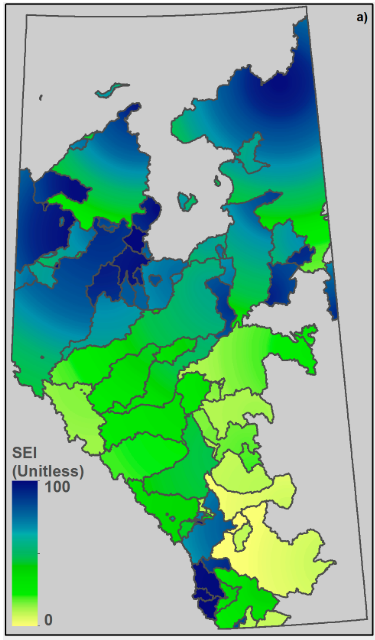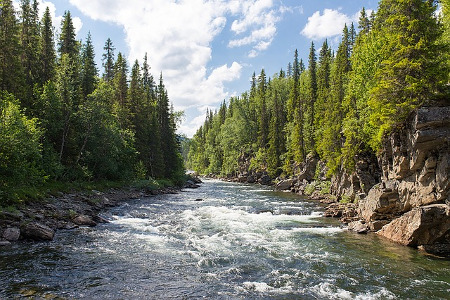Promoting source water protection against wildfires in Alberta
By François-Nicolas Robinne of Global Water Futures
North America is perpetually burning, or so it seems! California is experiencing year-long fire seasons, the last two years have been the worst fire seasons on record in British Columbia, and the town of High Level in northern Alberta was evacuated late-May to the out-of-control Chuckegg Creek wildfire. With the hot and dry conditions we have already experienced this spring, it may be a harbinger of another rough summer.
In a context of the climate crisis in which wildfires in Canada will likely happen more often, get bigger and be more severe, learning to live with wildfires also means learning to live with their consequences. This includes fatalities, billions of dollars’ worth of damage, as well as possible impairment of our water supplies, which is growing topic of concern for many communities. In particular, water contaminated by excess nutrients, sediments, and heavy metals transported from burned areas can degrade water treatability and pose serious challenges to downstream drinking water utilities [1,2].

After a severe wildfire, forested watersheds often display altered hydrologic functioning leading to higher runoff and erosion. For example, the speed at which water seeps into the ground versus flowing on the surface into creeks may change. The result is water quality impairments [3] which are of particular concern when those watersheds are sources of drinking-water for downstream communities. This is because drinking-water treatment utilities might not be fully prepared to deal with sudden post-fire water quality changes. Assessing the exposure of these utilities to wildfire-caused alteration of their source water is therefore a first logical step towards mitigating the effects of wildfire, as is the creation of a source water protection strategy.
In a recent study published in the MDPI journal Forests, an analysis was conducted of source-water exposure to wildfire activity in Alberta [4]. We selected 94 drinking-water treatment plants that receive their water supply from forested watersheds and examined factors such as how substances in the water are diluted, number of water consumers, forest cover, surface water availability, and fire danger.
Our results show that more than 60% of the population of Alberta receives water from forested sources. Highest Source Exposure Index scores, meaning those water sources potentially most contaminated by the effects of wildfire, were mostly displayed in source watersheds in the Rocky Mountains and southern Alberta. Most of the 94 watersheds, however, displayed a medium-to-high score and were located in the north-central part of the province. Large watersheds in central and south-eastern Alberta, usually showing lower tree cover, displayed the lowest scores. Our results also point to the disproportionate exposure of drinking water utilities serving very-small and small communities, including several Indigenous communities.

Figure 1: Source Exposure Index for forested watersheds providing drinking water in Alberta. Higher values indicate higher exposure levels.
The implications of our results for source water protection and wildfire management in Alberta are important because they could encourage utilities to include wildfire risks in their drinking water safety plans. The results could also help Alberta Wildfire prioritize and protect the most exposed watersheds. It must be noted, however, that most of the stakeholders involved in water governance and management, from researchers to water providers, are only somewhat aware of the fire-water problem. Furthermore, standardized methods and tools to assess and mitigate water contamination risks from wildfire do not currently exist. Our study was meant to start the process of addressing these gaps and is a first step towards the development of a framework and a pan-Canadian strategy that can help assess and manage wildfire risks to water security in the country.
Looking ahead, this study raises three questions that will have to be addressed:
- How do we prioritize the protection of source watersheds? Large communities usually have better financial capabilities to invest in mitigation actions and are therefore more resilient in comparison to smaller systems [5]. Should community vulnerability therefore be factored into future risk analyses?
- Does fire have a role in protecting source watersheds? Most forests of Alberta are fire-prone, meaning that wildfires will eventually happen no matter how much we try to fight them. Many of our forests are also fire-dependent, meaning fires are a strong determinant of forest health and they eventually influence the forest’s capacity to provide ecosystem services, such as drinking water [6]. An increased use of prescribed, controlled burning in source watersheds is certainly an option to consider [7].
- What are the public health implications of water pollution from upstream burned areas? There is surprisingly limited research on this topic for both drinking-water and other water uses, such as recreational. Although we currently lack direct evidence, scientific knowledge of water pollution suggests that changes in water quality happening after a fire could be detrimental in some way to public health [8].
This research was supported by the Canadian Water Network and Global Water Futures. More details on the project can be found here, and the open-access study can be downloaded here.

– – – – –
François-Nicolas Robinne, PhD, Global Water Futures postdoctoral fellow, robinne@ualberta.ca
References
1. Hohner, A. K.; Rhoades, C. C.; Wilkerson, P.; Rosario-Ortiz, F. L. Wildfires Alter Forest Watersheds and Threaten Drinking Water Quality. Acc. Chem. Res. 2019, 14, 58.
2. Emelko, M. B.; Silins, U.; Bladon, K. D.; Stone, M. Implications of land disturbance on drinking water treatability in a changing climate: Demonstrating the need for “source water supply and protection” strategies. Water Res. 2011, 45, 461–472.
3. Smith, H. G.; Sheridan, G. J.; Lane, P. N. J. Wildfire effects on water quality in forest catchments: a review with implications for water supply. J. Hydrol. 2011, 396, 170–192.
4. Robinne, F.-N.; Bladon, K. D.; Silins, U.; Emelko, M. B.; Flannigan, M. D.; Parisien, M.-A.; Wang, X.; Kienzle, S. W.; Dupont, D. P. A Regional-Scale Index for Assessing the Exposure of Drinking-Water Sources to Wildfires. Forests 2019, 10, 384.
5. McFarlane, K.; Harris, L. M. Small systems, big challenges: review of small drinking water system governance. Environ. Rev. 2018, 26, 378–395.
6. Brandt, J. P.; Flannigan, M. D.; Maynard, D. G.; Thompson, I. D.; Volney, W. J. A. An introduction to Canada’s boreal zone: Ecosystem processes, health, sustainability, and environmental issues. Environ. Rev. 2013, 21, 207–226.
7. Kolden, C. A. We’re Not Doing Enough Prescribed Fire in the Western United States to Mitigate Wildfire Risk. Fire 2019, 2, 10.
8. Richardson, S. D.; Plewa, M. J.; Wagner, E. D.; Schoeny, R.; DeMarini, D. M. Occurrence, genotoxicity, and carcinogenicity of regulated and emerging disinfection by-products in drinking water: A review and roadmap for research. Mutat. Res. Mutat. Res. 2007, 636, 178–242.
